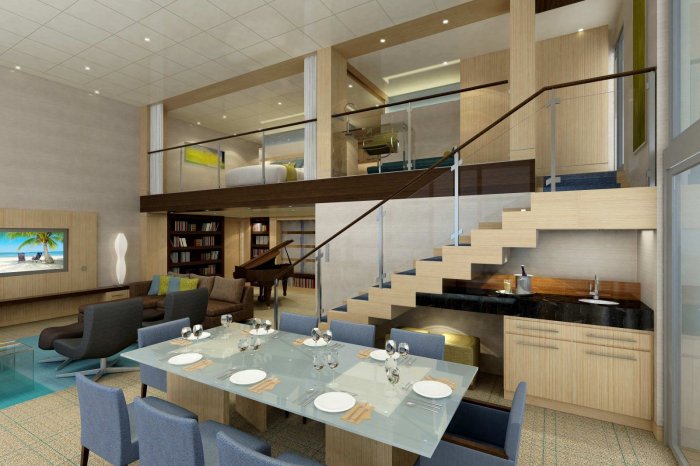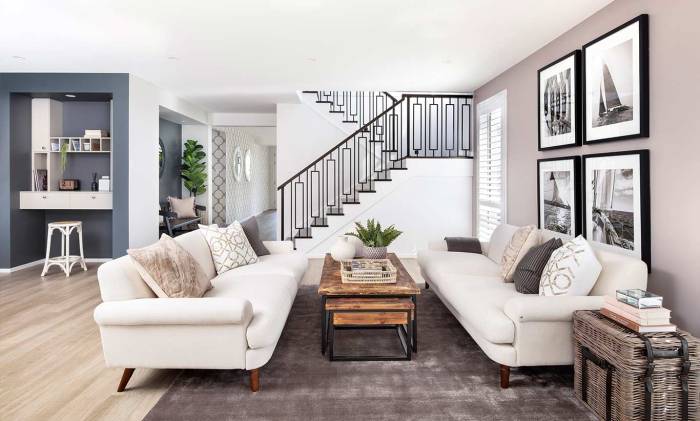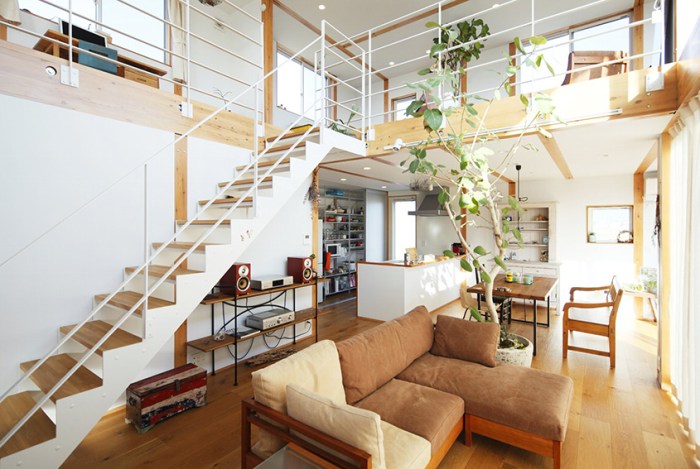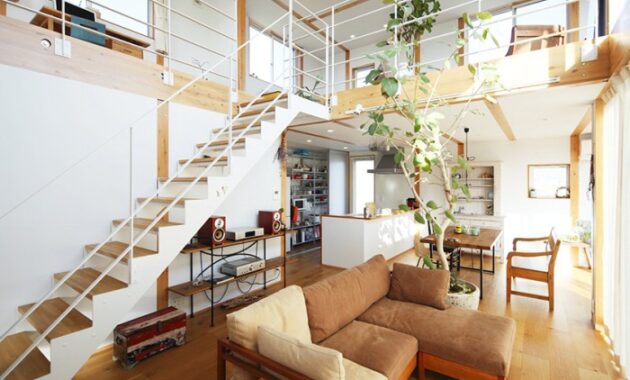Bi level house interior design – Bi-level house interior design presents a unique set of challenges and opportunities. With its split-level layout, a bi-level home offers a distinct spatial dynamic, allowing for creative design solutions to maximize functionality and aesthetic appeal. This guide explores the intricacies of designing a bi-level home, delving into the architectural characteristics, space planning, and interior design elements that contribute to a harmonious and captivating living environment.
From maximizing natural light to creating seamless transitions between levels, we’ll cover the key considerations for designing a bi-level home that’s both functional and stylish. Whether you’re planning a complete renovation or simply seeking inspiration for your current bi-level space, this comprehensive guide will provide valuable insights and practical tips.
Designing for Flow and Functionality: Bi Level House Interior Design

A bi-level home presents unique opportunities for maximizing space and functionality. By carefully considering the layout, you can create a home that feels spacious, inviting, and seamlessly connected.
Maximizing Space and Natural Light
Open floor plans are a popular choice for bi-level homes, as they promote a sense of spaciousness and allow natural light to flow throughout the house. To maximize space, consider these design strategies:
- Use a central staircase:A central staircase, located in the heart of the home, creates a natural flow between the levels while minimizing wasted space. This design allows for open living areas on both levels, enhancing the feeling of spaciousness.
- Embrace open concept living:Combine the living, dining, and kitchen areas into one open space to create a sense of unity and maximize light flow. This design is particularly effective in bi-level homes, where natural light can easily be directed through the space.
- Maximize windows:Large windows on both levels allow natural light to flood the interior. Consider using floor-to-ceiling windows to create a connection between the interior and the outdoors.
- Utilize skylights:Skylights provide additional natural light and can help brighten even the darkest corners of the home.
Maximizing Storage and Organization
Bi-level homes often have unique storage challenges, especially in the lower level. Here are some strategies to maximize storage and organization in this type of home:
- Utilize the under-stair space:The space under the stairs is often overlooked but can be a valuable storage area. Consider adding built-in shelves, drawers, or a closet to maximize this space.
- Create a mudroom or entryway:A designated mudroom or entryway on the lower level provides a convenient space to store shoes, coats, bags, and other items.
- Maximize wall space:Use wall-mounted shelves, floating cabinets, or built-in storage units to create additional storage without taking up floor space.
- Optimize closets:Use closet organizers and maximize vertical space to create efficient storage solutions.
Creating Seamless Flow Between Levels
The stairs are a key element in creating a seamless flow between the upper and lower levels of a bi-level home. Here are some design considerations:
- Choose a visually appealing staircase:A well-designed staircase can become a focal point in the home. Consider using materials that complement the overall design aesthetic and add visual interest.
- Create a welcoming landing:The landing at the top of the stairs should be spacious enough to accommodate furniture and create a transition between the levels. Consider adding a small seating area or a decorative piece to make the landing more inviting.
- Use consistent flooring:Using the same flooring material on both levels helps to create a sense of continuity and flow.
- Consider open railings:Open railings allow light and air to flow freely between the levels, creating a sense of openness.
Mastering the Upper Level
The upper level of a bi-level home presents a unique opportunity to create distinct and personalized spaces. Whether you envision a luxurious master suite, a cozy living room, or a vibrant playroom, the upper level offers the potential for both functionality and aesthetic appeal.
Let’s explore some design concepts to transform this space into a haven for relaxation, entertainment, and personal expression.
Designing a Luxurious Master Suite
A master suite on the upper level can be a true sanctuary, offering privacy and a sense of escape from the hustle and bustle of everyday life. To achieve this, consider incorporating elements that promote tranquility and comfort.
- Walk-in Closet: A spacious walk-in closet is a must-have for any master suite. It provides ample storage for clothing, shoes, and accessories, keeping the bedroom clutter-free and organized. A well-designed walk-in closet can feature custom shelving, drawers, and lighting, creating a functional and stylish space for your wardrobe.
- Private Balcony: A private balcony adds a touch of luxury and provides a serene outdoor space to enjoy morning coffee or evening cocktails. A balcony can be designed with comfortable seating, planters for greenery, and perhaps even a small bistro table for enjoying meals al fresco.
- Spa-Like Bathroom: Transforming the bathroom into a spa-like retreat is a key element in creating a luxurious master suite. Consider incorporating a soaking tub, a walk-in shower with multiple showerheads, heated floors, and luxurious finishes like marble or granite.
Soft lighting, aromatherapy diffusers, and plush towels complete the spa experience.
Designing a Comfortable and Inviting Living Room
The upper-level living room can be a central gathering space for family and friends. Creating a comfortable and inviting atmosphere is key to making this space a welcoming retreat.
Bi-level house interior design often presents unique challenges, especially when considering the flow between levels. A common concern is maximizing space utilization, which is particularly relevant when dealing with a smaller footprint. For example, a 1700 sq ft house interior design can be effectively planned to create a sense of spaciousness, even with the added complexity of a bi-level layout.
By incorporating smart design choices, like open floor plans and strategic use of natural light, bi-level homes can achieve a sense of openness and functionality that enhances the overall living experience.
- Fireplace: A fireplace adds warmth and ambiance to any living room. A gas fireplace is a convenient and efficient option, while a wood-burning fireplace offers a more traditional and rustic feel. Consider adding a mantel for displaying artwork, photos, or decorative objects.
- Built-in Bookshelves: Built-in bookshelves are a stylish and functional way to store books, display decorative items, and add architectural interest to the space. They can be designed to fit seamlessly into the room’s layout and can be customized with different finishes and lighting options.
- Cozy Reading Nook: A cozy reading nook is a perfect spot for curling up with a good book. This can be created by adding a comfortable armchair, a small table for a lamp and a drink, and a soft rug. Consider placing the reading nook near a window for natural light or a fireplace for warmth.
Maximizing Natural Light and Creating a Bright and Airy Atmosphere
Natural light is essential for creating a bright and airy atmosphere in any space, especially on the upper level of a bi-level home. Here are some ideas for maximizing natural light:
- Large Windows: Large windows allow ample natural light to flood the space. Consider using floor-to-ceiling windows to maximize the view and bring in the most light.
- Skylights: Skylights are a great way to add natural light to areas that may not have traditional windows. They can also create a sense of spaciousness and bring the outdoors in.
- Light-Colored Walls and Furniture: Light-colored walls and furniture reflect natural light, making the space feel brighter and more spacious. Avoid using dark colors that absorb light and make the space feel smaller.
Optimizing the Lower Level
The lower level of a bi-level home presents a unique opportunity to create functional and stylish spaces that complement the upper level’s design. By strategically utilizing the space, you can maximize its potential to meet the needs of your family and lifestyle.
Designing a Functional Kitchen
A well-designed kitchen on the lower level can be the heart of your home, providing a gathering place for family and friends. Incorporating features like a breakfast bar, pantry, or built-in appliances can enhance both functionality and style.
- Breakfast Bar:A breakfast bar is a versatile addition to any kitchen, providing a casual dining space for quick meals or a place to gather for conversation. It can be integrated into the existing cabinetry or designed as a standalone element.
Consider using a contrasting countertop material to create visual interest and define the space.
- Pantry:A well-organized pantry is essential for any kitchen, especially in a bi-level home where storage space might be limited. Consider incorporating a walk-in pantry or a deep, pull-out pantry system to maximize storage capacity. This allows you to keep your kitchen clutter-free and efficiently organize your food supplies.
- Built-in Appliances:Built-in appliances, such as ovens, microwaves, and refrigerators, can seamlessly integrate into the kitchen design, creating a streamlined and sophisticated look. They can also save valuable counter space and improve the overall flow of the kitchen.
Organizing a Family Room, Bi level house interior design
The lower level family room is a prime location for relaxation and entertainment. Designing this space to accommodate the needs of your family is key.
- Media Center:A dedicated media center is a must-have for any family room. Consider a built-in entertainment unit with ample storage for electronics, books, and games. Incorporate a comfortable seating area with plush sofas and armchairs to create a cozy and inviting atmosphere.
- Play Area for Children:If you have young children, creating a designated play area within the family room is a practical solution. Consider using rugs, colorful storage bins, and age-appropriate furniture to create a fun and stimulating space for your kids to play and explore.
- Comfortable Seating Area:A comfortable seating area is essential for any family room, providing a place to relax and unwind after a long day. Consider using a variety of seating options, such as sofas, armchairs, and ottomans, to accommodate different preferences.
Creating a Guest Room or Home Office
The lower level is an ideal location for a guest room or home office, offering privacy and separation from the main living areas.
- Guest Room:When designing a guest room, prioritize comfort and functionality. Consider incorporating a comfortable bed, a dresser, a nightstand, and ample storage space.
- Home Office:A home office on the lower level can provide a quiet and dedicated workspace. Include a desk with ample work surface, a comfortable chair, and adequate lighting. Consider adding built-in shelves or cabinets to maximize storage and organization.
Elevating the Interior Design

A bi-level home offers a unique canvas for creating a stylish and cohesive interior design. The split-level layout allows for distinct spaces with varying heights and angles, creating a dynamic and visually appealing environment. By strategically using color palettes, textures, and incorporating elements that complement the home’s architectural features, you can transform your bi-level home into a haven that reflects your personal style.
Color Palettes and Textures
The right color palette can tie together the different levels of a bi-level home, creating a sense of harmony and flow. Choosing a neutral base color for the walls and floors will create a clean and spacious feel, while adding pops of color through furniture, accessories, and artwork can add personality and interest.
Bi-level homes offer a unique design challenge, requiring careful consideration of space flow and visual connections between levels. The use of light, color, and materials can effectively bridge the gap between the two floors. For inspiration, consider exploring the possibilities of ai house interior design , which can generate innovative ideas and layouts for any home, including bi-level spaces.
By incorporating elements of both traditional and modern design, you can create a truly cohesive and stylish interior for your bi-level home.
Here are some tips for using color palettes in a bi-level home:
- Consider the natural light: The amount of natural light in each level can influence the best color choices. Lighter colors can help to brighten up darker spaces, while darker colors can add warmth and intimacy to sun-drenched areas.
- Use a cohesive color scheme: Choose a color scheme that complements the existing architectural features of the home. For example, if the home has a lot of wood accents, consider using warm, earthy tones.
- Create visual interest with contrasting textures: Mixing different textures can add depth and dimension to the interior. For example, you can pair smooth, polished surfaces with rough, textured materials like stone or wood.
Interior Design Elements
The unique architectural features of a bi-level home present an opportunity to incorporate design elements that complement the home’s structure and enhance its overall appeal.Here are some key elements to consider:
- Staircase Design: The staircase is a focal point in a bi-level home. Consider using a statement staircase design with bold materials, interesting railings, or unique lighting fixtures.
- Open Floor Plans: Maximize the flow and openness of the space by incorporating open floor plans. This can be achieved by using large windows, sliding doors, or by removing walls to create a seamless transition between levels.
- Lighting: Proper lighting is essential for highlighting the unique features of a bi-level home. Use a combination of natural light and artificial lighting to create a warm and inviting ambiance.
Personalized Touches
Incorporating personalized touches is crucial for creating a unique character for your bi-level home. This can be achieved through a variety of means, including:
- Artwork and Decor: Use artwork and decorative pieces that reflect your personal style and interests. This can include paintings, sculptures, photographs, or even vintage finds.
- Furniture Selection: Choose furniture that complements the architectural features of the home and reflects your personal taste. Consider using statement pieces that add a touch of personality to the space.
- Accent Walls: Create a focal point in each level by using accent walls with bold colors, unique textures, or interesting patterns.
Choosing the Right Furniture
Selecting the perfect furniture for a bi-level home is crucial to maximizing space and creating a harmonious flow. Furniture choices should not only be aesthetically pleasing but also functional, complementing the unique design of a bi-level home.
Furniture Suitable for a Bi-Level Home
Furniture selection for a bi-level home requires careful consideration of space constraints and the desired flow between levels. Here are some key furniture pieces to consider:
- Modular Sofas:Modular sofas are ideal for open floor plans, as they can be configured in various ways to create distinct seating areas while maintaining a sense of openness. For example, a sectional sofa can be arranged to separate the living room from the dining area, creating a visual barrier without obstructing the flow.
- Multi-Functional Furniture:Bi-level homes often have limited space, so multi-functional furniture is essential. A storage ottoman can serve as both seating and storage, while a Murphy bed can transform a guest room into a home office during the day.
- Floating Shelves:Floating shelves are perfect for adding storage without taking up valuable floor space, particularly in smaller areas like hallways or landings. They can be used to display books, artwork, or decorative items, adding visual interest and functionality.
- Slim Dining Tables:Bi-level homes may have limited space for a traditional dining table. Slim dining tables with extendable leaves are ideal for small spaces, as they can be expanded to accommodate guests when needed.
Defining Areas with Furniture
Furniture can be strategically placed to define different areas within an open floor plan, creating a sense of separation without physical walls.
- Area Rugs:Area rugs are a versatile tool for defining different zones in a bi-level home. A large rug can create a distinct living area, while smaller rugs can delineate seating areas or workspaces.
- Bookshelves:Bookshelves can be used to create visual boundaries between different areas. For example, a bookshelf placed between the living room and the kitchen can serve as a room divider while adding storage and display space.
- Accent Chairs:Placing accent chairs in strategic locations can create intimate seating areas within an open floor plan. For instance, a pair of chairs positioned near a window can create a cozy reading nook.
Selecting Furniture That Complements the Style and Scale
The furniture you choose should complement the style and scale of your bi-level home. Here are some tips:
- Consider the Overall Style:If your bi-level home has a modern aesthetic, choose furniture with clean lines and minimalist designs. For a traditional style, opt for furniture with ornate details and classic silhouettes.
- Scale and Proportion:Pay attention to the scale and proportion of furniture pieces. In a bi-level home, it’s essential to choose furniture that is proportionate to the size of the space. Oversized furniture can overwhelm a small area, while undersized furniture can get lost in a large space.
- Materials and Finishes:Consider the materials and finishes of your furniture. Natural materials like wood and leather can create a warm and inviting atmosphere, while metal and glass can add a modern touch.
Lighting for Impact
In a bi-level home, lighting plays a crucial role in defining the space, highlighting its unique features, and creating a welcoming ambiance. A well-designed lighting plan goes beyond mere illumination; it enhances the overall design, creating a cohesive and functional environment.
Utilizing Natural Light
Maximizing natural light is essential in a bi-level home, especially in the lower level where natural light can be limited. Large windows, skylights, and glass doors allow sunlight to flood the space, making it feel more open and airy. Strategically placed mirrors can reflect natural light, further brightening the space.
Creating Different Moods with Lighting
Lighting can be used to create different moods and atmospheres in various areas of the home.
Ambient Lighting
Ambient lighting provides general illumination, creating a relaxed and comfortable atmosphere. Recessed lighting, track lighting, and pendant lights are common options for ambient lighting.
Accent Lighting
Accent lighting highlights specific features, adding depth and dimension to the space. It can be used to showcase artwork, sculptures, or architectural details. Table lamps, sconces, and spotlights are effective accent lighting options.
Task Lighting
Task lighting provides focused illumination for specific activities, such as reading, cooking, or working. Under-cabinet lighting, desk lamps, and pendant lights over kitchen islands are examples of task lighting.
Innovative Lighting Solutions
Bi-level homes present unique opportunities for innovative lighting solutions.
LED Strip Lighting
LED strip lighting can be used to create dramatic effects, highlighting architectural features or outlining the staircase.
Fiber Optic Lighting
Fiber optic lighting can be used to create a sense of wonder and magic, especially in the lower level. It can be used to create starry night ceilings or to illuminate hidden nooks and crannies.
Dimmers and Smart Lighting
Dimmers allow you to adjust the brightness of lights, creating different moods and atmospheres. Smart lighting systems offer even more control, allowing you to adjust the brightness and color temperature of lights remotely.
Conclusion

Designing a bi-level home is an exciting journey that blends architectural features with personalized style. By understanding the unique aspects of this home type, you can create a space that flows effortlessly, maximizes functionality, and reflects your individual taste. From the strategic placement of furniture to the selection of lighting and decorative accents, every detail contributes to the overall aesthetic and functionality of your bi-level home.
With careful planning and creative inspiration, you can transform your bi-level house into a haven that seamlessly blends comfort, style, and functionality.
FAQ Explained
What are the advantages of a bi-level home?
Bi-level homes offer advantages like increased natural light, distinct living areas, and potential for privacy. They often feature unique architectural details and can be more affordable than single-story homes.
How do I create a sense of flow between levels?
Using consistent flooring, color palettes, and furniture styles can create visual continuity. Open stairwells and strategically placed windows can enhance the sense of connection.
What are some tips for maximizing storage in a bi-level home?
Utilize built-in shelves, under-stair storage, and vertical space for efficient organization. Consider using multi-functional furniture like ottomans with storage.

